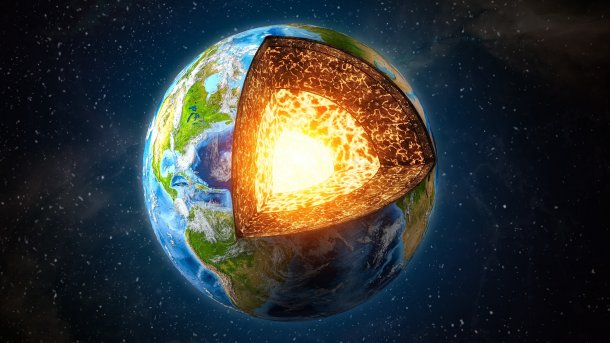Geophysics: The Earth's inner core rotates more slowly and changes direction
The Earth's inner core changes its rotation relative to the rest of the planet. Scientists see this as confirmation of a roughly 70-year oscillation.

An artistic look inside the earth
(Image: Maxx-Studio/Shutterstock.com)
The Earth's inner core, a solid sphere of iron and nickel the diameter of the Earth's moon, is surrounded by a liquid outer core. Researchers have long assumed that the inner core rotates independently of the rest of the planet. However, the exact movement has been controversial until now: some studies have indicated a continuous rotation, others an oscillating movement. A recent publication in the scientific journal "Nature " now provides evidence for a model in which the inner core initially rotates in one direction, then slows down, changes direction and rotates in the opposite direction – in a cycle of around 70 years.
Seismic waves as a window into the Earth's interior
The international team of researchers led by seismologist John E. Vidale has analyzed decades of seismic data. They focused on so-called seismic twin earthquakes, i.e. earthquakes that repeat at the same location with a similar course. The seismic waves caused by such quakes travel through the Earth's interior and are influenced by the Earth's inner core. By comparing the seismograms of twin earthquakes that occurred years apart, it is possible to draw conclusions about changes in the inner core.
The researchers identified 121 twin earthquakes between 1991 and 2023 in the Sandwich Islands region in the South Atlantic. The waves of these quakes were recorded by seismic arrays in North and Central America.
A comparison of the seismograms showed that the waveforms often changed significantly over the years, but then returned to an earlier pattern. From this, the scientists concluded that at certain times the inner core returned to the same position in relation to the Earth's mantle and crust as before. From the pattern of seismogram changes, they conclude that the inner core rotated in one direction from 2003 to around 2008. From 2009 onwards, it rotated two to three times more slowly in the opposite direction.
These observations are consistent with a model in which the inner core initially rotates in one direction in a cycle lasting around 70 years, then slows down and finally changes direction.
Rotation of the outer core drives "Geodynamo
While the exact movement of the inner core is still being researched, the significance of the convection currents in the outer core has long been known. They drive the dynamo of Earth's core, which generates around 95 percent of the Earth's magnetic field. It works according to the principles of magnetohydrodynamics: the hot, liquid and electrically conductive material rising in the outer core generates electric currents. These in turn induce magnetic fields, which are amplified by the convection currents. This creates a self-perpetuating dynamo process that maintains the earth's magnetic field.
This magnetic field is vital as it protects the Earth from high-energy cosmic radiation and the solar wind. Without this protective shield, the emergence of higher life on Earth would probably not have been possible.
Melting ice also slows down the Earth's rotation
Changes in the rotation of the Earth's inner core could also affect the length of the day, depending on whether the core rotates with or against the Earth's rotation. Although the Earth's inner core forms a third of the Earth's mass due to its high density, the changes would be so small that they would be overshadowed by other effects, says John E. Vidale. In addition to the processes in the Earth's interior, these effects also include mass shifts on the Earth's surface, such as the movements of the oceans or the accelerated melting of the polar ice caps due to global warming.
A study published in March came to the conclusion that the melting of ice has slowed the Earth's rotation by around one millisecond per day since the end of the 20th century. This had delayed the need to adjust the atomic clocks to the Earth's rotation, the so-called leap seconds, by several years. The movements of the Earth's inner core, the dynamics of the outer core and mass displacements on the Earth's surface therefore interact and influence the rotation of our planet in a complex way.
(vza)